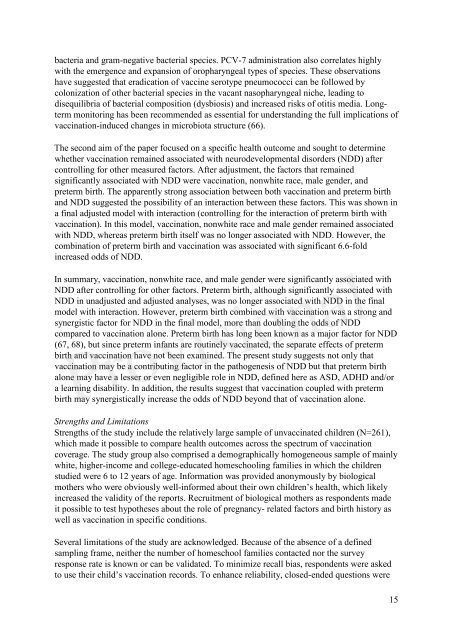Provisional
age-of-autism-vaccination-outcomes-anthony-r.-mawson-brian-d.-ray-azad-r.-bhuiyan-binu-jacob
age-of-autism-vaccination-outcomes-anthony-r.-mawson-brian-d.-ray-azad-r.-bhuiyan-binu-jacob
Create successful ePaper yourself
Turn your PDF publications into a flip-book with our unique Google optimized e-Paper software.
acteria and gram-negative bacterial species. PCV-7 administration also correlates highly<br />
with the emergence and expansion of oropharyngeal types of species. These observations<br />
have suggested that eradication of vaccine serotype pneumococci can be followed by<br />
colonization of other bacterial species in the vacant nasopharyngeal niche, leading to<br />
disequilibria of bacterial composition (dysbiosis) and increased risks of otitis media. Longterm<br />
monitoring has been recommended as essential for understanding the full implications of<br />
vaccination-induced changes in microbiota structure (66).<br />
The second aim of the paper focused on a specific health outcome and sought to determine<br />
whether vaccination remained associated with neurodevelopmental disorders (NDD) after<br />
controlling for other measured factors. After adjustment, the factors that remained<br />
significantly associated with NDD were vaccination, nonwhite race, male gender, and<br />
preterm birth. The apparently strong association between both vaccination and preterm birth<br />
and NDD suggested the possibility of an interaction between these factors. This was shown in<br />
a final adjusted model with interaction (controlling for the interaction of preterm birth with<br />
vaccination). In this model, vaccination, nonwhite race and male gender remained associated<br />
with NDD, whereas preterm birth itself was no longer associated with NDD. However, the<br />
combination of preterm birth and vaccination was associated with significant 6.6-fold<br />
increased odds of NDD.<br />
In summary, vaccination, nonwhite race, and male gender were significantly associated with<br />
NDD after controlling for other factors. Preterm birth, although significantly associated with<br />
NDD in unadjusted and adjusted analyses, was no longer associated with NDD in the final<br />
model with interaction. However, preterm birth combined with vaccination was a strong and<br />
synergistic factor for NDD in the final model, more than doubling the odds of NDD<br />
compared to vaccination alone. Preterm birth has long been known as a major factor for NDD<br />
(67, 68), but since preterm infants are routinely vaccinated, the separate effects of preterm<br />
birth and vaccination have not been examined. The present study suggests not only that<br />
vaccination may be a contributing factor in the pathogenesis of NDD but that preterm birth<br />
alone may have a lesser or even negligible role in NDD, defined here as ASD, ADHD and/or<br />
a learning disability. In addition, the results suggest that vaccination coupled with preterm<br />
birth may synergistically increase the odds of NDD beyond that of vaccination alone.<br />
<strong>Provisional</strong><br />
Strengths and Limitations<br />
Strengths of the study include the relatively large sample of unvaccinated children (N=261),<br />
which made it possible to compare health outcomes across the spectrum of vaccination<br />
coverage. The study group also comprised a demographically homogeneous sample of mainly<br />
white, higher-income and college-educated homeschooling families in which the children<br />
studied were 6 to 12 years of age. Information was provided anonymously by biological<br />
mothers who were obviously well-informed about their own children’s health, which likely<br />
increased the validity of the reports. Recruitment of biological mothers as respondents made<br />
it possible to test hypotheses about the role of pregnancy- related factors and birth history as<br />
well as vaccination in specific conditions.<br />
Several limitations of the study are acknowledged. Because of the absence of a defined<br />
sampling frame, neither the number of homeschool families contacted nor the survey<br />
response rate is known or can be validated. To minimize recall bias, respondents were asked<br />
to use their child’s vaccination records. To enhance reliability, closed-ended questions were<br />
15


